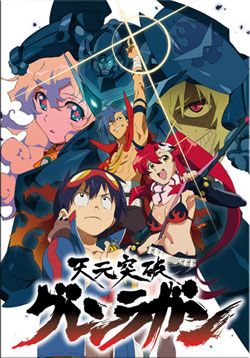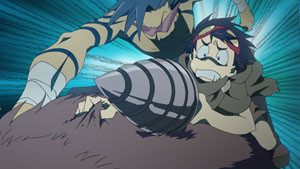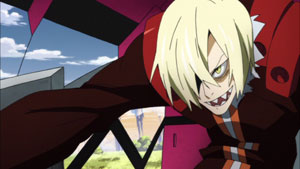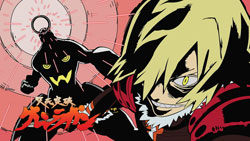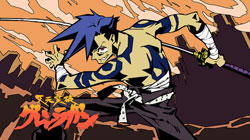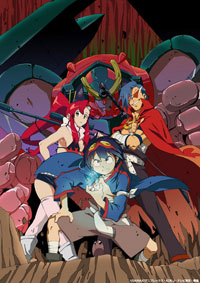 Logo handmade by Bannister
Column by Scott Green
Logo handmade by Bannister
Column by Scott Green
Bandai Entertainment Inc. announced today that it will distribute Aniplex’s release of GURREN LAGANN which was created by anime powerhouse studio GAINAX (Evangelion, Gunbuster, The Wings of Honneamise). The 27-episode science fiction, comedy action series centers on Simon, Kamina and Yoko, youths who live in an underground village on a future earth. They become embroiled in a conflict with surface “Beastmen” who pilot mech known as Gunmen, one of which they take for themselves and name GURREN, and lead the battle against the Beastmen. Recently the series won “best television series” and “best character design” at the 2008 Tokyo Animation Fair (TAF) Because of the overwhelming desire by fans to have this title released, Bandai Entertainment Inc. will create a subtitle only initial release of the series in three parts. Vol. 1 of the sub only release will contain episodes 1-9 and be released on July 8 th for $29.98 with a pre-sale occurring the weekend of Anime Expo 2008. Vol. 2 and Vol. 3 of the subtitled only version will be released in August and September respectively. In early 2009, an all new English dub version will be released with Japanese audio and English subtitles with both a regular and special editions. More details on the 2009 release pattern and spec will be announced later this year. The series had previously been licensed by ADV Films, the first three episodes were streamed through The Anime Network, and the title was scheduled for release in March. When ADV put their new releases on moratorium, Gurren Lagann was removed from their schedule.
The following is a repost of AICN Anime Gurren Lagann preview...
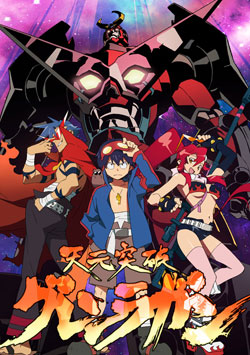
Anime Spotlight: Gurren Lagann
Bear with me, apparently this is going to be long...
Neon Genesis Evangelion is still a contentious topic. Its detractors can argue that it's hollow, that it's overrated, that it's pretentious. But, can anyone make a case that the scenes like the bloody birth image of the demonic looking robot ripping its way out of the Direc Sea aren’t stunning visuals? Gurren Lagann takes that potential for striking images that still lingers in giant robot anime and applies it to an exciting, in spirit back to basics, maelstrom.
One of the hallmarks of high minded giant robot anime in the last decade or so has been its reliance on mystery. There is no a real twist to Gurren Lagann the way that there is in the opening episodes of Rahxephon and there are no real "Soylent Green is people" revelations the way that there are in Neon Genesis Evangelion, but Gurren Lagann is the kindof story that you don't want spoiled. If you can make it through the series without catching images from later episodes or reading too much about the plot, you'll come to appreciate your self-imposed information blackout.
That said, the series starts with a Star Wars (New Hope) open. Curtains part to unveil an epic prologue, with galaxies literally exploding. In updated Leiji Matsumoto fashion, banners furl in space as the captain of a battle ship walks onto his bridge, wearing a cape with the insignia of a flaming, shades wearing skull. One of his officers informs him that all the lights they can see crowding the heavens are enemies ready to stand in opposition. This captain spits back a "damn the torpedoes" style response, and...
The anime dissolves to the narrow holes of the diggers. Every day, these anonymous workers burrow with small hand drills hoping to expand their subterranean village and earn a "pig-mole steak" as their reward. Beyond the endless rock and endless work, young, unimpressive Simon has a notion that someday he might find a treasure buried in the rock, and that personal hope drives him to dig further. And, one day he finds a small glowing drill-bit like spiral that pleases him, if no one else.
The other dream to which Simon is party is his elder friend/mentor/"brother" Kamina's wish to rebel against the village's slovenly task master as a first step in the ultimate ambition of moving from their enclosed cavern to the surface. Kamina, a bit of a braggart with tribal tattoos and an oversized sword, refuses to listen to the stubborn insistences that humans need to stay where they belong, off the beastman controlled surface. Except in the wake of one of Kamina's rebellions, a beastman's giant minotaur-esque robot gunman brakes through into the village, with the sniper rifle wielding, bikini wearing hottie Yoko in pursuit. In the midst of this battle, Simon manages to dig up his own gunman: a rather unimpressive machine that's pretty much just a person-tall head with arms and legs.

